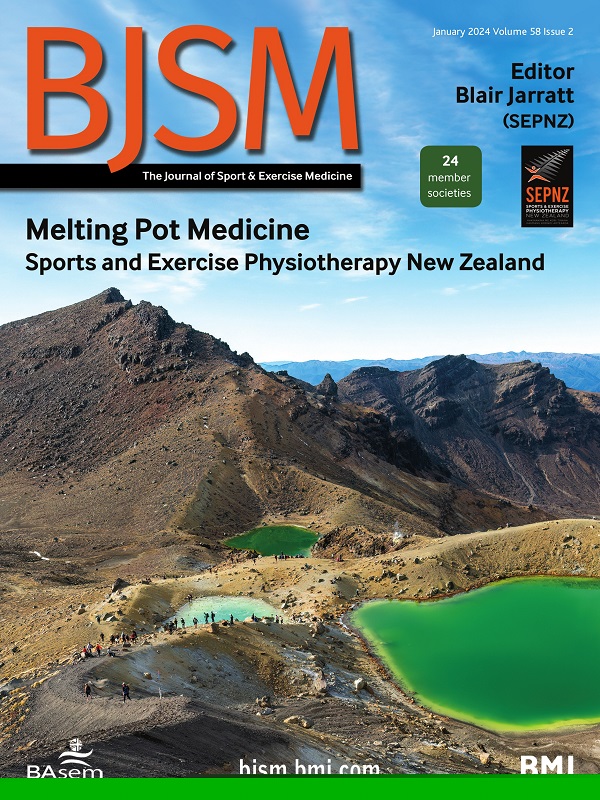High-intensity interval training for cardiometabolic health in adults with metabolic syndrome: a systematic review and meta-analysis of randomised controlled trials
IF 11.6
1区 医学
Q1 SPORT SCIENCES
引用次数: 0
Abstract
Objective To assess the effectiveness of high-intensity interval training (HIIT) compared with traditional moderate-intensity continuous training (MICT) and/or non-exercise control (CON) for modification of metabolic syndrome (MetS) components and other cardiometabolic health outcomes in individuals with MetS. Design Systematic review and meta-analysis Data sources Five databases were searched from inception to March 2024. Study appraisal and synthesis Meta-analyses of randomised controlled trials (RCTs) comparing HIIT with MICT/CON were performed for components of MetS (waist circumference (WC), systolic blood pressure (SBP), diastolic blood pressure (DBP), high-density lipoprotein cholesterol (HDL-C), triglyceride (TG), and fasting blood glucose (BG)) and clinically relevant cardiometabolic health parameters. Subgroup moderator analyses were conducted based on the intervention duration and HIIT volume. Results Out of 4819 studies, 23 RCTs involving 1374 participants were included (mean age: 46.2–67.0 years, 55% male). HIIT significantly improved WC (weighted mean difference (WMD) –4.12 cm, 95% CI –4.71 to –3.53), SBP (WMD –6.05 mm Hg, 95% CI –8.11 to –4.00), DBP (WMD –3.68 mm Hg, 95% CI –5.70 to –1.65), HDL-C (WMD 0.12 mmol/L, 95% CI 0.04 to 0.20), TG (WMD –0.34 mmol/L, 95% CI –0.41 to –0.27) and BG (WMD –0.35 mmol/L, 95% CI –0.54 to –0.16) compared with CON (all p<0.01). HIIT approaches demonstrated comparable effects to MICT across all parameters. Subgroup analyses suggested that HIIT protocols with low volume (ie, <15 min of high-intensity exercise per session) were not inferior to higher volume protocols for improving MetS components. Conclusion This review supports HIIT as an efficacious exercise strategy for improving cardiometabolic health in individuals with MetS. Low-volume HIIT appears to be a viable alternative to traditional forms of aerobic exercise. The datasets analysed in this review are available from the corresponding author on reasonable request.高强度间歇训练促进代谢综合征成人的心脏代谢健康:随机对照试验的系统回顾和荟萃分析
目的 评估高强度间歇训练(HIIT)与传统的中等强度持续训练(MICT)和/或非运动控制(CON)相比,在改善 MetS 患者的代谢综合征(MetS)成分及其他心脏代谢健康结果方面的有效性。设计 系统综述和荟萃分析 数据来源 检索了从开始到 2024 年 3 月的五个数据库。研究评估与综述 对比较 HIIT 与 MICT/CON 的随机对照试验 (RCT) 以及临床相关的心脏代谢健康参数进行了 MetS 组成部分(腰围 (WC)、收缩压 (SBP)、舒张压 (DBP)、高密度脂蛋白胆固醇 (HDL-C)、甘油三酯 (TG) 和空腹血糖 (BG))和临床相关的心脏代谢健康参数的荟萃分析。根据干预持续时间和 HIIT 运动量进行了分组慢动作分析。结果 在 4819 项研究中,纳入了 23 项 RCT,涉及 1374 名参与者(平均年龄:46.2-67.0 岁,55% 为男性)。HIIT 能明显改善 WC(加权平均差 (WMD) -4.12 厘米,95% CI -4.71 至 -3.53)、SBP(WMD -6.05 毫米汞柱,95% CI -8.11 至 -4.00)、DBP(WMD -3.68 毫米汞柱,95% CI -5.70至-1.65)、HDL-C(WMD 0.12 mmol/L,95% CI 0.04至0.20)、TG(WMD -0.34 mmol/L,95% CI -0.41至-0.27)和BG(WMD -0.35 mmol/L,95% CI -0.54至-0.16)。在所有参数上,HIIT 方法与 MICT 的效果相当。亚组分析表明,在改善 MetS 成分方面,低运动量的 HIIT 方案(即每次高强度运动少于 15 分钟)并不逊色于高运动量方案。结论 本综述支持将 HIIT 作为改善 MetS 患者心脏代谢健康的有效运动策略。低运动量的 HIIT 似乎是传统有氧运动形式的一种可行替代方案。本综述分析的数据集可向通讯作者索取。
本文章由计算机程序翻译,如有差异,请以英文原文为准。
求助全文
约1分钟内获得全文
求助全文
来源期刊
CiteScore
27.10
自引率
4.90%
发文量
217
审稿时长
3-8 weeks
期刊介绍:
The British Journal of Sports Medicine (BJSM) is a dynamic platform that presents groundbreaking research, thought-provoking reviews, and meaningful discussions on sport and exercise medicine. Our focus encompasses various clinically-relevant aspects such as physiotherapy, physical therapy, and rehabilitation. With an aim to foster innovation, education, and knowledge translation, we strive to bridge the gap between research and practical implementation in the field. Our multi-media approach, including web, print, video, and audio resources, along with our active presence on social media, connects a global community of healthcare professionals dedicated to treating active individuals.

 求助内容:
求助内容: 应助结果提醒方式:
应助结果提醒方式:


